Gluteal Strain
What is Gluteal Strain?
A Gluteal strain is a tear or stretching of one of the three muscles in the buttocks: the gluteus maximus, gluteus medius, or gluteus minimus. These muscles are responsible for extending the hip, abducting the hip, and rotating the hip. A gluteal strain can occur when these muscles are suddenly and forcefully stretched or contracted.
A Gluteal strain can really hurt the buttocks. The gluteus maximus, gluteus medius, or gluteus minimus are the three main muscles that can cause buttock pain. Sharp pain in your hips or buttocks might be brought on by actions like getting up from a chair, carrying weight while walking, or ascending stairs. In addition, a gluteal strain may also be indicated by severe, prolonged soreness in your hip region. Do not hesitate to contact your doctor if you need help identifying the cause of your buttock pain.
Each of these gluteal muscles plays a crucial role in stabilizing the pelvis and enabling controlled hip movements. If the demands placed on a muscle exceed its typical limits, it can result in a tear, leading to a gluteal strain and subsequent buttock discomfort.
Individuals who engage in activities that require intense muscle contractions, such as sprinters, hurdlers, long jumpers, and especially triple jumpers, are at a higher risk of tearing one of their gluteal muscles. This is due to the high-intensity contractions needed to propel themselves out of a stretched position.
A gluteal strain may also be referred to as:
- Buttock pain
- Gluteus medius tendinitis
- Glute pain
- Gluteus maximus strain
- Sore buttock
Which are Gluteal Muscles?
The ‘glutes,’ as they are affectionately known worldwide, constitute a group of three muscles that extend from the pelvic rim (iliac crest) and sacrum diagonally downward towards the femur (thigh bone). They are layered, with the deepest and smallest being the gluteus minimus muscle, running vertically down the outside of the hip, sandwiched between the gluteus medius and the largest and most superficial, the gluteus maximus.
Let’s delve into each muscle individually and explore the movements they govern to gain insight into the source of your buttock discomfort:
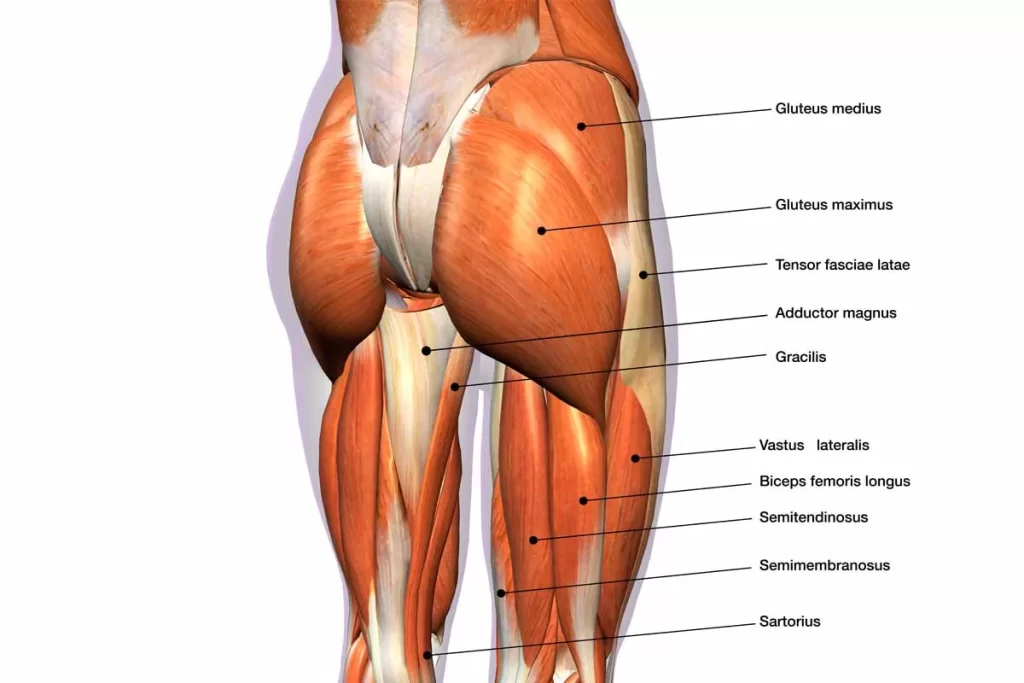
Gluteus Maximus Muscle:
As the name suggests, it is the largest among the trio and is considered the most potent muscle in the human body. It primarily handles hip extension, which is responsible for moving the leg backward. The gluteus maximus plays a pivotal role in walking (or running) as it propels the body forward during the push-off phase in the gait cycle. It enables you to straighten your hips when rising from a chair or ascending stairs. Pain in the gluteus maximus can significantly impact your ability to stand up from a chair and navigate stairs with ease.
Gluteus Medius Muscle:
The middle muscle is responsible for abduction, which involves moving the leg sideways. It plays a critical role in maintaining the level of your hips when walking or running, preventing the characteristic swaying of the hips seen in a runway model’s stride. The adductor muscle group on the inner thigh collaborates with the gluteus medius to stabilize your pelvis when shifting your weight from one leg to the other. Its connection with the iliotibial band stabilizes the femur (thigh bone) on the tibial articular surfaces during standing, walking, and jumping. Any inhibition, weakness, or tear in this muscle can affect the biomechanics of the entire lower limb, potentially leading to conditions such as ITB syndrome, shin splints, ankle injuries, or Achilles tendonitis in addition to gluteus medius pain.
Gluteus Minimus Muscle:
The gluteus minimus, a secondary muscle, assists in hip extension. It is situated deep and somewhat in front of the gluteus medius. The gluteus minimus aids in moving your leg sideways away from your body’s midline (abduction) and internally rotating the thigh. It works in tandem with the gluteus medius to stabilize the hip and pelvis when the opposite leg is raised from the ground.
How does a Gluteal Strain happen?
When your gluteal muscles are required to contract forcefully while in a stretched position, it can result in overloading and the formation of small, microscopic tears in the gluteal muscle fibers. These tears can vary in size, from a small bundle of fibers to larger, deeper splits along the length of the gluteal muscles. In response, your nervous system initiates muscle contractions and increases muscle tension as a protective measure. This temporary shortening of the muscle is essential for the healing process.
During activities that involve stretching or contracting your gluteal muscles, you may experience a sharp, stinging sensation. This sensation occurs because the more you stretch the muscle, the more you disrupt the healing process of the scar tissue that is attempting to mend the gluteal muscle fibers. It’s akin to continuously picking at a scab, hindering the healing process.
Movements such as bending forward to pick up an object from the floor or transitioning from standing to sitting can stretch the gluteal muscles, leading to buttock pain. Pain during gluteal muscle contraction is often experienced when rising from a chair, with the severity of pain increasing with deeper seat heights. Even ascending stairs place the gluteal muscles under full tension while they are in a stretched and loaded state.
Gluteal strains typically occur when the gluteal muscles undergo sudden contractions, often while they are in a stretched position. This can happen during rapid acceleration while running, especially when going uphill, or when executing explosive jumps. It can also result from lifting excessive weight, such as during loaded squats or lunges in the gym. These situations can lead to gluteus maximus or gluteus medius pain.
Common causes of gluteal strains include:
- Sudden deceleration of the hip and leg, such as when landing from a jump.
- Vigorous contraction of the gluteal muscles during activities like jumping, lunges, or stair sprints
- The rapid deceleration of an overstretched muscle due to a quick change of direction, is seen in movements like jumping from a lunge position or performing plyometric jumps.
What are the Causes of Gluteal Strain?
Acute Injury:
An acute injury occurs when you suddenly experience buttock pain following a training session or a fall.
- Overuse: This can happen when you increase your running distance too quickly or engage in a sudden burst of repetitive jumps.
- Overload: Increasing the weight on the leg press machine too rapidly can lead to overloading of the gluteal muscles.
- Overstretch: Running uphill sprints can force the muscles to contract from their stretched position, leaving them vulnerable to gluteal strain.
Chronic wear and tear:
Weakness Muscle fatigue can contribute to buttock pain, especially in jumpers and runners who lack conditioning for longer distances. When you push your muscles beyond their limits during extended runs, they can become fatigued, causing an uneven rocking motion in your hips. This places additional strain on the muscles and can result in gluteus maximus pain.
- Poor technique: Incorrect movement patterns during training, such as improper form during squats, lunges, or jumps, can significantly increase the load on your gluteal muscles. This may cause the forces around your hip muscles to concentrate on specific fibers, leading to tension and potential gluteus medius pain.
- Inadequate warm-up: Sudden and intense contractions, like jumping or sprinting, when your muscles are not properly prepared, can increase the risk of gluteal muscle tears.
- Excessive stretching: Excessive stretching of the muscles against resistance, as seen in weightlifting exercises like deadlifts, can strain the gluteal muscles. When the load is applied on both sides of the tendon, it needs to contract and lengthen simultaneously. This same principle applies to exercises like jumping lunges, squats, and plyometric training.
- Wrong shoes: Inadequate foot support can lead to an abnormal distribution of muscle forces along the outside of your leg, placing greater stress on these muscle fibers compared to the inner part. This can lead to faster fatigue and potential tears in these outer fibers.
What are the Symptoms of Gluteal Strain?
Mild:
- A deep, dull ache in your buttocks or hip.
- You’ve discovered that this ache is alleviated by movement, rest, or the application of heat or cold.
- Pain occurs when you twist or turn your body while keeping your feet still.
- Buttock pain comes and goes.
- General immobility in the back of your thigh.
- Mild tenderness in the area.
- There was no noticeable bruising.
- Pain is experienced at the end of your stride, with the back of your buttocks aching as you contract the gluteal muscles to swing your leg forward for the next step.
Moderate:
- Sharp buttock pain.
- Loss of strength.
- Clicking sensation in your hip.
- Limited range of motion, making it challenging to bend down and pick something up from the floor.
- Swelling and bruising around your hip and buttocks.
- Pain throughout the entire swing and weight-bearing phase of walking.
- A feeling of hip instability.
- Increased pain when putting weight on the affected leg.
- Apprehension about balancing on one leg
- Difficulty climbing stairs.
- Numbness in your buttocks or hips indicates a potential nerve injury, which can be serious.
Serious:
- Intense, persistent buttock pain that doesn’t improve with changes in position, heat, or medication.
- Sensations of pins and needles or tingling and numbness in your buttocks.
- Audible pop at the time of injury (which may suggest a complete rupture).
- Severe and immediate swelling and bruising are visible around your hip and buttocks.
- Sharp pain when squeezing your buttock muscles.
- Incapability to maintain weight on the involved leg.
- Unable to stand on one leg.
- Difficulty climbing stairs.
Self-test to identify Gluteal Strain
If you notice a significant difference between the two sides or experience buttock pain during these tests, it may indicate a potential gluteal strain.
Supine Length Test: Gluteal Length
To assess the right side:
- Lie on your back and lift your right knee towards your chest.
- Hold your right knee and gently pull it closer to your chest. This action stretches the gluteus maximus muscle.
- Bend your right knee and pull your leg across your body towards your left shoulder. This lengthens the gluteus medius muscle.
- Now resembles the right side to the left side of your body. If you feel buttock pain, it could be suggestive of a gluteal strain.
Seated Length Test: Length Test
To assess the right side:
- Start by sitting on the ground with both legs prolonged in front of you. Note that this requires good hamstring flexibility.
- Place your right foot on the outside of your straight (left) leg, somewhat resembling a modified Marichyasana C pose.
- Keep your back straight and pull your right knee towards your chest while rotating your upper body towards your right leg.
- Compare the right side to the left side for any buttock pain. If discomfort arises, a gluteal strain may be a consideration.
Standing lunge: stretch under contraction
To test the right side:
- Start by standing and holding onto a chair or table for support.
- Extend your right leg behind you, lowering into a deep lunge position. If possible, touch your right knee to the floor.
- Bend ahead from your hips towards the left knee in front. This should induce a deep stretch in the gluteus of your left buttock.
- Now compare the right side to the left side for any buttock pain. If you experience discomfort, it might suggest a gluteal strain.
Crossed Leg Stretch: Sitting Stretch
To Test the Right Side:
- Begin in a cross-legged sitting position on the floor.
- Adjust your legs so that your left leg is underneath your right leg, forming a triangle shape.
- You should sense a resonant stretch in the gluteal muscles of the right side.
- Lean forward over your legs to intensify the stretch.
- Compare the right side to the left side for any buttock pain. If discomfort arises, it could indicate a gluteal strain.
Figure 4 Stretch: End of Range Stretch
To assess the right side, start by lying flat on your back with your legs bent.
- Put your right foot over your opposite knee.
- Gently pull your legs towards your chest until you feel a deep stretch across your right buttock.
- Compare the right side to the left side for any buttock pain. If discomfort is present, it may suggest a gluteal strain.
Leg Swings in Standing: Contract and Relax
- Stand next to a chair or wall for balance, if needed.
- Lift your opposite leg and swing it in front of you and then behind you, like a pendulum.
- Perform 10 to 12 swings on each side.
- Compare the right side to the left side for any buttock pain. If you feel discomfort, it might indicate a gluteal strain.
Bridge: Inner Range Contraction
- Lie flat on your back with your knees bent at a 90-degree angle and your heels on the floor.
- Lift your hips until they are in line with your shoulders & knees.
- Hold this position for a two-second count, then lower your hips.
- Compare the right side to the left side for any buttock pain. If you experience discomfort, it could be suggestive of a gluteal strain.
Front Lunge: Contraction
- Start by standing elevated with your feet together.
- Step one foot in front of you and lower into a lunge position, ensuring that your knee remains behind your toes.
- Push back to a standing position through your heel and glutes.
- Compare the right side to the left side for any buttock pain. If discomfort is present, it may indicate a gluteal strain.
What are the grades of Gluteal Strain?
Grade 1: A Grade 1 gluteal strain entails the tearing of approximately 5% to 10% of the muscle fibers due to overstretching or overloading. This can apply to any of the three layers of the gluteal muscles or involve all three simultaneously.
Grade 2: A Grade 2 gluteal strain encompasses the tearing of roughly 10% to 80% of muscle fibers, resulting from overstretching or overloading. This range covers a wide spectrum of potential muscle involvement within the gluteal region, making it a more complex situation. To achieve a more precise diagnosis, a sonar examination can be valuable in such cases.
Grade 3: A Grade 3 gluteal strain involves the tearing of approximately 80% to 100% of muscle fibers due to overstretching or overloading. When it reaches the 100% mark, it signifies a complete rupture, wherein the muscle is torn into two separate parts. As these severed parts lose their connection, they no longer exert leverage over the joints and cannot generate movement. Interestingly, despite the extensive muscle and nerve fiber damage, this level of injury may not be as painful as the significant loss of function it entails.
How to Diagnose the Gluteal Strain?
The skilled physiotherapists are quite knowledgeable about the complex structure of your hip and buttock areas. Muscles, ligaments, nerves, and tendons are just a few of the elements that must be examined within this intricate region. We methodically evaluate numerous factors, including muscular strength, length, range of motion, flexibility, and stability, through a thorough assessment. We can determine the degree of your tissue damage thanks to this thorough evaluation. During the evaluation, a skilled physical therapist dissects your hip’s complex biomechanics, allowing us to establish a precise diagnosis. We identify whether and to what extent the Gluteus Maximus, Gluteus Medius, or Gluteus Minimus muscles are impacted.
The gluteus muscles work together as a unit, although each has a unique purpose. While the Gluteus Medius moves the leg outward, the Gluteus Maximus extends the hip and, to a lesser extent, the lower back. When one leg carries weight, such as during running, it is very important to maintain hip stability and level. To determine which particular gluteal muscle is injured and causing your discomfort, we evaluate these muscles both with and without weight-bearing.
A highly individualized approach will adjust the treatment strategy to your particular needs based on the particulars of your injury. A physiotherapist is therefore skilled at identifying gluteal strains and buttock pain.
Diagnostic Imaging:
- X-rays: X-rays primarily visualize bones and are not useful for diagnosing gluteal muscle strains, which involve soft tissue. However, they can be valuable in ruling out fractures, especially if your injury resulted from a traumatic incident like a fall or car accident.
- Sonar (Ultrasound): Diagnostic ultrasound provides a detailed view of soft tissue, including muscle bellies and tendon attachments, making it the preferred imaging modality for diagnosing gluteal muscle strains. It allows for precise visualization of the tear’s location, orientation, length, and depth.
- MRI: An MRI is a costly imaging procedure typically ordered by specialists. For uncomplicated luteal strains, an MRI is not necessary for diagnosis. Therefore, if you are experiencing buttock pain, an MRI would not be considered essential.
Why is my buttock pain not going away?
It’s possible that your injury originated as a Grade 1 gluteal strain several months ago when you had to suddenly chase after your dog. Initially, it might have felt like a minor discomfort or ‘niggle,’ prompting you to take a few days of rest before resuming your regular exercise routine. However, when you continue training or engaging in daily activities despite persistent buttock soreness, your body attempts to send you a message. In response to the injury, the affected muscle contracts to protect itself.
While in this contracted state, it cannot function optimally, much like trying to play tennis while carrying a bag full of groceries. The muscle loses its ability to lengthen and contract effectively, diminishing the force it can generate. Over time, a minor tear can progress into a larger one until the pain becomes too severe to either contract or stretch your gluteal muscles.
Typically, Gluteal Muscle Group injuries occur near the center (belly) of the muscle and often coincide with tendinitis, which is inflammation at the tendon-bone junction. If the muscle pain doesn’t deter you, nerve pain may follow, transforming the initial dull ache into a sharp, stabbing sensation.
What NOT to do:
- Avoid using anti-inflammatory medications, especially in the first 48 hours, as they may impede the healing process.
- Resist the urge to stretch your glutes through the pain, even if they feel ‘tight.’ Stretching can actually widen the area that needs to heal, akin to disrupting a scab.
- Refrain from applying heat, such as from warm water bottles.
- Do not continue walking, running, or jogging through the pain.
- Never ignore worsening pain, as it could signal a more profound issue.
- Don’t leave the injury untreated.
What you should do:
- Follow a POLICE or PRICE protocol involving protection, optimal loading, ice, compression, and elevation.
- Maintain a pain-free range of movement.
- Engage in progressive loading exercises that are pain-free.
- Schedule an appointment to confirm the diagnosis and assess the severity of your luteal strain.
Activities to avoid, as they may exacerbate the injury:
- Walking up inclines or ramps.
- Climbing stairs.
- Participating in stair-running drills.
- Performing single-leg jumps.
- Wearing high heels.
- Sitting with your thighs crossed over.
- Sitting cross-legged.
- Engaging in spinal rotations and gluteal stretches
- Sitting in deep chairs.
- Cycling.
What are the Complications that occur with Gluteal Strain?
The gluteal muscle group endures significant strain during a typical day, especially during activities like walking, climbing stairs, and getting in and out of the car. These daily actions can greatly impact your life, and the impact is even more pronounced for those who engage in activities like running or cycling. The gluteal muscles play a vital role in maintaining pelvic stability during single-leg weight-bearing, so any issue in this area can potentially lead to gluteal maximus pain with each step you take. Resting can be challenging due to the constant demands on these muscles, making active rest with crutches for a brief period an effective option to achieve positive results.
Rehabilitation protocols that are poorly designed, often emphasizing single-plane movements or low-load exercises exclusively, may be diligently followed but fail to deliver the desired outcomes. The hip joint is inherently multidimensional, allowing for movements in various directions, including front to back, side to side, circular motions, or even combinations of these movements. Muscles are engaged in various directions, such as when kicking a ball while running. Therefore, giving up is not a viable solution. It’s essential to consider a comprehensive treatment approach to overcome gluteal medius pain.
Medications or injections can certainly provide symptomatic relief, allowing for more comfortable movement or even pain-free motion. However, this relief is akin to mopping up water without addressing the underlying issue, which is akin to fixing a burst pipe. Ideally, during this period of pain-free movement facilitated by medication, the root cause should be addressed to prevent the pain from returning once the effects of the medication wear off. Moreover, relying solely on medication can carry the risk of unpleasant side effects, such as constipation or peptic ulcers.
What is Physiotherapy treatment for Gluteal Strain?
Once we have identified the cause of your gluteal strain, we can initiate the appropriate techniques to rehabilitate your specific injury. Our approach encompasses hands-on methods such as myofascial release, massage, deep dry needling, joint mobilization, and nerve glides. We also utilize electrotherapy, laser therapy, EMS, TENS, or ultrasound, in addition to tailored exercise prescriptions and, if necessary, immobilization, to guide you through each phase of rehabilitation.
1st Phase: Protection and Initial Healing Protect
We have observed that patients often continue to bear weight on the injured leg, causing further strain. To prevent further damage to your injured gluteal area and knee joint, it’s advisable to use crutches and wear a brace to distribute the load more evenly.
- Rest: Avoid activities that exacerbate your pain and minimize weight-bearing on the injured leg. Crutches can help alleviate pressure. Once the pain subsides, refrain from testing it and allow adequate time for healing.
- Ice: Applying ice cubes wrapped in a towel to your knee can reduce pain and inflammation while expediting the healing process. For the first three days or until swelling diminishes, apply an ice pack for 20 minutes every two hours, ensuring there’s a towel between the ice and your skin to prevent freeze burns.
- Compress: To support your knee joint and prevent swelling, consider using strapping or elastic compression bandages. This can be achieved through taping or using tube-grip bandages, effectively controlling swelling.
- Elevate: Elevate your calf, ensuring it’s higher than your heart, to assist in draining pooled blood in your leg. Spend 15-minute intervals during the day with your calf raised.
2nd Phase: Establishing a Pain-Free Range of Motion
During the examination, we will determine your safe range of motion and identify factors contributing to your pain. We will focus your exercises within the pain-free range, such as 0–30 degrees while avoiding movements that cause discomfort. By the end of this phase, you should be able to perform movements within these boundaries.
As your rehabilitation progresses, we aim to expand your pain-free range of motion while reducing the intensity of pain in your restricted range.
3rd Phase: Tissue Healing
We closely monitor your pathology’s progress, tracking fibrous tissue formation, reattachment, and scar tissue healing. On a cellular level, we can expedite tissue healing using techniques like dry needling, laser therapy, ultrasound, and electrotherapy.
4th Phase: Tissue Stress and Healing Capacity
During each session, we reevaluate whether your tissues can withstand tensile, elastic, and compression forces. Isometric muscle contractions, which involve muscle activation without movement, help maintain surrounding muscle activity without compromising the injury site.
5th Phase: Muscle Strength and Full Range of Motion
Regaining a full range of motion in the muscle fibers is crucial. Scar tissue within the injury site must lengthen and align to enable unrestricted muscle contraction. Techniques such as massage, stretches, and neurodynamic mobilizations help achieve this goal. By the end of this phase, you should be able to walk comfortably and climb stairs without pain.
6th Phase: Eccentric Muscle Strength
Expect some discomfort when initially contracting the muscle as we break down abnormal fibrous tissue adhesions. Muscle contractions can occur in two directions: contraction and shortening, as well as contraction and lengthening. Both types of exercises are essential to conditioning the muscle fibers to absorb force. You should be able to lower yourself slowly into a deep side squat with minimal pain upon completing this phase.
7th Phase: Concentric Muscle Strength
Contraction and shortening of the muscle during contraction involve strength and power exercises that gradually progress as healing occurs. Frequent testing will determine if you can transition from non-weight bearing to full weight bearing (walking without crutches). Our physiotherapist will guide and monitor your gluteal muscles’ response to normal activities like walking, climbing stairs, and driving. By the end of this phase, you should be able to contract your gluteal muscles against resistance, such as side squats with resistance bands.
8th Phase: Return to Activity Testing
This phase entails a gradual return to your previous level of normal activities and training, assessing your injury’s ability to withstand repetitive loading without flare-ups. Our physiotherapist guides you in safe increments, making adjustments as necessary.
9th Phase: High Speed, Power, and Proprioception
Gluteal muscles must undergo testing under high load and speed to ensure they can meet your body’s demands. Our physiotherapist will guide you in returning to normal activities, including challenging your muscles beyond their usual boundaries to gauge their response to various forces. Ultimately, we prepare you to return to sports activities, including jumps, landings, sprints, and more.
10th Phase: Sport-Specific Training
The final stage of rehabilitation, lasting 2-4 weeks, focuses on functional rehabilitation tailored to your specific sport. Our physiotherapist will design exercises to strengthen muscles relevant to your sport. Success in this phase includes gaining knowledge throughout the rehabilitation program and participating at full power and speed while minimizing the risk of future injuries.
Our physiotherapist will provide customized exercises that will help develop the muscles necessary for your sport, depending on what you play. A successful outcome is when you have learned new information from the rehabilitation program and are able to engage with all of your strength and speed, in addition to lowering your risk of further injury.
Other Medical treatments for Gluteal Strain
If you find yourself trapped in a cycle of ‘rest for relief’ and ‘movement causes pain’ due to your gluteal strain, consulting your GP for analgesic medication might be a viable option for pain management. However, it’s essential to note that anti-inflammatories are not advisable for prolonged use, as they can potentially impact tendon integrity and increase the risk of future ruptures, further exacerbating your discomfort in the buttock area.
Injections into the affected area should not be your primary treatment choice. If you ever reach a point where an injection, typically cortisone, appears to be the only solution, it’s crucial to complement it with physiotherapy treatment. Failing to do so may result in the need for subsequent injections. Utilizing this pain-free window after injection can provide an opportunity to initiate the necessary changes that your muscles require for healing and recovery.
While chiropractic manipulation of the hip joint may offer symptomatic relief for your buttock pain, it does not directly influence the muscle’s healing process.
Biokinetics can be considered once your physiotherapist has given you the green light. Typically, this occurs when your buttock pain has subsided and you have regained full range of motion.
Surgical treatment for Gluteal Strain
Surgical repair for a gluteal strain is generally discouraged due to the muscle’s innate ability to regenerate. There are limited studies available on this topic, mainly because the prevailing belief is that surgical intervention may yield similar or even inferior results compared to conservative care. Surgery carries risks of complications and excessive scar tissue formation, making conservative treatment the safer choice. Surgical repair is typically only considered for full-thickness (grade 3) tears of the gluteus medius tendon, primarily due to its critical role in hip stability.
When physical therapy and injections fail to provide enduring relief, surgical intervention becomes a consideration. In many instances, a torn gluteus medius can be repaired through arthroscopic procedures involving the meticulous stitching of the torn portion of the gluteus medius tendon back to the bone using tiny suture anchors. The objective of this surgical approach is to restore strength to the gluteus medius muscle.
In cases where the gluteus medius muscle tear is extensive, an open gluteus medius repair may be necessary. Anchors are employed to stabilize the repair or attach the tendon securely to the bone. In exceptionally rare cases where the gluteus medius has atrophied, a transfer of the gluteus maximus muscle may be considered to reestablish strength in your hip abductors.
FAQ
Is walking good for gluteal strain?
Walking can be an essential aspect of your rehab and recovery from gluteal tendinopathy, but there are a few things to keep in mind. Overdoing it may even make matters worse.
Should I stretch a strained glute?
The easiest way to avoid gluteal strains is to stretch and warm up properly before your activity. Your gluteal muscles may be stretched straight immediately. Exercise 3, gluteal isometrics, can be used to start strengthening your gluteal muscles as soon as the initial pain subsides and you just feel a dull discomfort.
How do you fix a glute strain?
Rest: Your doctor will urge you to stay away from strenuous workouts and sports. Ice: Use ice to reduce discomfort and swelling. Compression: To lessen discomfort, pressure should be given with an elastic bandage to the area that is afflicted. Elevation: To reduce swelling, you will be told to elevate your leg.
How do you treat a gluteus strain?
Pain relief and healing are both facilitated by ice/heat treatment. Faster healing using ultrasound. Massage soft tissues to loosen up tense muscles. Joint range-of-motion exercises that involve stretching.
Does glute pain go away?
Normal pain is mild & passes after a few days or a week, but deep gluteal syndrome produces pain that is typically more severe and persistent despite rest and simple home treatment. Deep gluteal syndrome is a component of, or has many symptoms with, a few different disorders.
How do you test for a gluteal strain?
The Resisted External Derotation Test is another orthopedic examination that evaluates for gluteal tendinopathy.
Test your single-leg stance.
Palpation of the greater trochanter.
Modified Ober’s Test (ADD/ADD-R).
Reference
Cilliers, R. (2021, February 23). Gluteus Muscle Strain (Hip). Well Health Pro. https://physiopretoria.co.za/pain/hip/gluteus-muscle-strain-hip

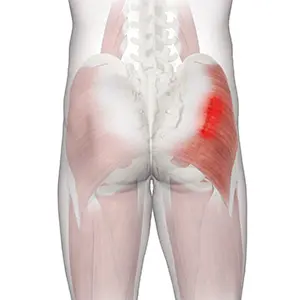
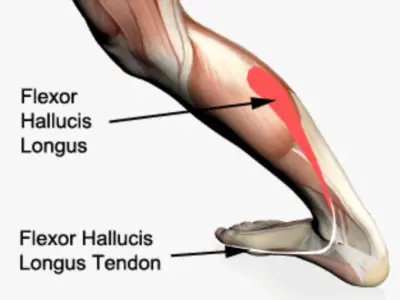
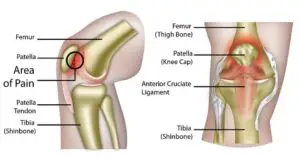
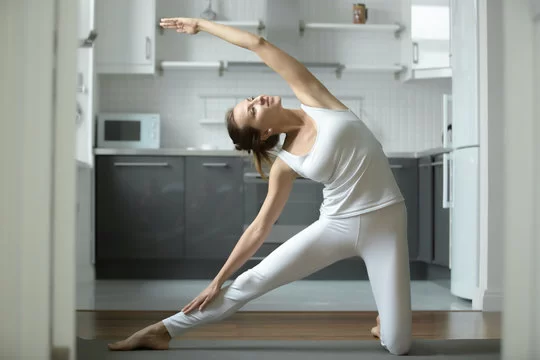

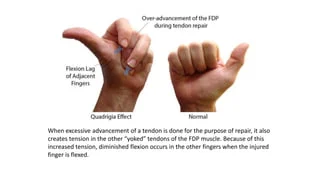
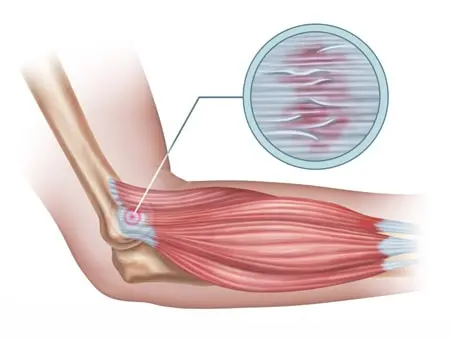
One Comment